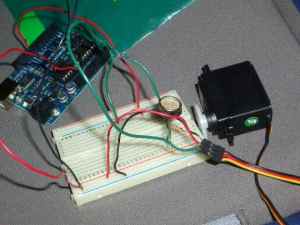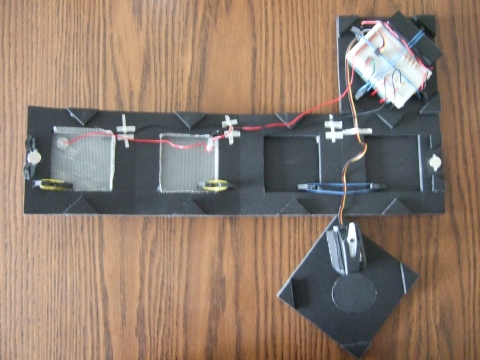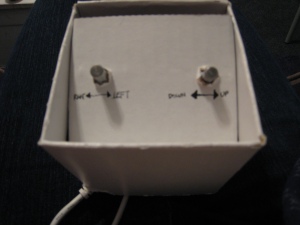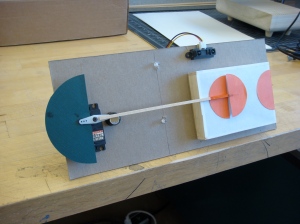Archive for the ‘Exercise 5: Cabinet of Curiosities’ Category
Christine Lee: Jerking Coffin
Arduino Sketch: Jerking_Coffin


How it would’ve worked:
When the lid of the coffin is on (photocell high), the coffin jerks the lid around (servo motor moving erratically); but when you open the lid (photocell value low), there’s nothing there but a thin slit at the bottom (servo motor stops moving). I got past the electronics and coding, but wasn’t able to begin the physical build up.
Video Demonstration (bad lighting)
Assignment 5 – Curiosity Cabinet
I decided to reinterpret the curiosity cabinet to be a box that you never really saw the internals or contents of. I did this using a servo with a modified arm that moves two panels and a pair of foil switches mounted to two doors. The box is hand-cut from black foamcore and held together using friction, neodymium magnets, and rubber bands (when the servo is active). The panels of the box are all sprung with rubber bands.
Video:
Picture of the Internals: (in case you are curious)

Contents of the curiosity box
Arduino Sketch: curiousityCube
Gabriela Uribe – Assignment 5
Curious Cabinet:
I built a safe that uses a potentiometer and a switch to insert a combination of three numbers. If the correct combination is used, a servo unlatches the safe’ door.
Nitelite
Curious Cabinet from Jim Toggweiler on Vimeo.
This ‘curious cabinet’ really functions like a night light. A tri-color LED and a yellow LED inside the box cycle through a range of colors. A Light Damping Resistor on the top of the box reads the amount of ambient light in the box’s environment and increases the speed of the color cycle and the intensity of light.
My code can be found in the video description on Vimeo.
Music box
here’s my cabinet of curiosities, a music box that uses a photocell to determine if the lid is opened
-david yen
Assignment 5 (Katherine) – etch-a-sketch
My curious cabinet is simple, it is only made out of two potentiometers one to control left and right, and the other to control up and down.
I wanted to learn more about processing so I found the processing code online, so it’s not written by me. The arduino code is similar to the graph code that we learned in class.
Arduino Sketch: <a title=”Arduino Sketch: etch” href=”http://code.arc.cmu.edu/~gregsaul/sketchDropBox/uploads/etch.pde” target=”_blank”>etch</a>
Assignments..Dave Rocco
Analog sensing/ curiosity cabinet
Mechanical (gears and levers)
Assignment 5- Charles Doomany
 I made a kinetic sculpture which changes states when the viewer approaches it. When the viewer is close to the sculpture the panel becomes illuminated (LEDs pulse fast) and the arm moves counterclockwise to complete the composition, as the viewer walks away from the sculpture, the arm moves clockwise and the illuminated panel pulses slower, returning to it’s inactive state. When the arm is in its retracted state the light sensor becomes hidden.
I made a kinetic sculpture which changes states when the viewer approaches it. When the viewer is close to the sculpture the panel becomes illuminated (LEDs pulse fast) and the arm moves counterclockwise to complete the composition, as the viewer walks away from the sculpture, the arm moves clockwise and the illuminated panel pulses slower, returning to it’s inactive state. When the arm is in its retracted state the light sensor becomes hidden.
Although the LEDs and the servo can operate independently I was unable to make them work together, it could have been an issue of power, supplying power to both the LEDs and the servo.
Cabinet or Curiosities- Rebecca Riggs
My cabinet of curities is a display case with the theme of dreams and imagination with flashing LEDS, a motion sensor, and a motor. The LEDs turn on when a button is pushed and the rate of the LEDS is controlled by a potentiometer. The motion sensor will also turn on the LEDs and turn them off.
There is a functional motor as well that turns a butterfly. Unofrtuantely this is not shown here because of issues with an appropriate external power source.
My code is here:
Arduino Sketch: <a title=”Arduino Sketch: cabinet” href=”http://code.arc.cmu.edu/~gregsaul/sketchDropBox/uploads/cabinet-1.pde” target=”_blank”>cabinet</a>
Cabinet of Curiosities – Kyle Vice
I demoed the Circus Cabinet in class, and I got the sound working later that day so I’ve included that in the video.
The elephant is lit by default, as a viewer approaches, the cat lights are turned on and the Tiger and Lion roar. When the spotlight is shined on the main stage, the character is changed between the Strongman and Ringmaster and crowd responds with lights and sound. There is also a push-button switch on the side to activate the crowd independent of changing characters.
In order to get the sound working and not sounding very fuzzy from the right channel I had to battle a bug in javasound on OS X. I added the fix to the processing.org forums.
Arduino Sketch: kv_CircusCabinet
Processing Sketch: kv_CircusSounds
 Leave a comment
Leave a comment
